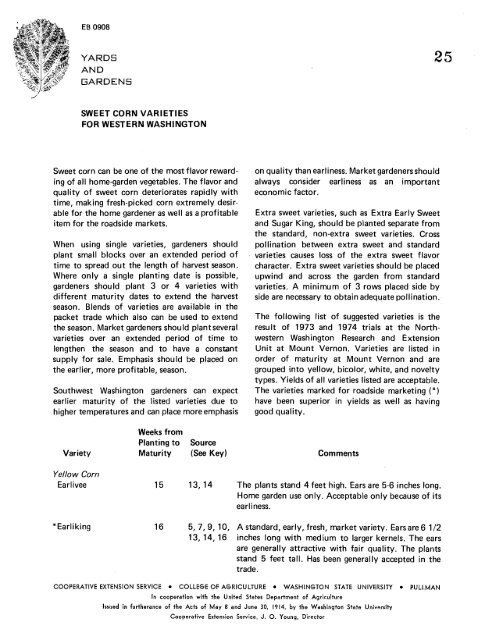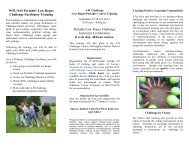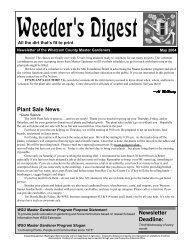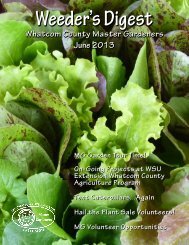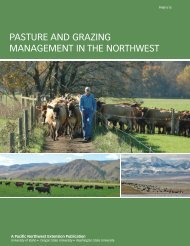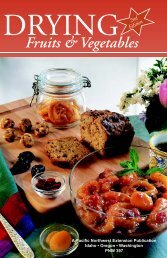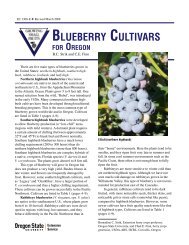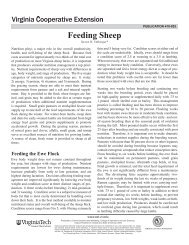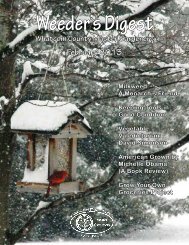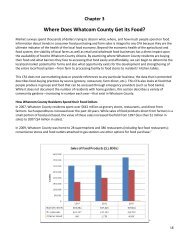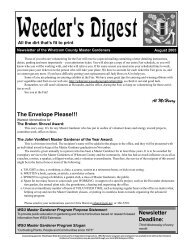Sweet Corn Varieties for Western Washington - WSU Whatcom ...
Sweet Corn Varieties for Western Washington - WSU Whatcom ...
Sweet Corn Varieties for Western Washington - WSU Whatcom ...
Create successful ePaper yourself
Turn your PDF publications into a flip-book with our unique Google optimized e-Paper software.
EB 0908<br />
YARDS<br />
AND<br />
GARDENS<br />
SWEET CORN VARIETIES<br />
FOR WESTERN WASHINGTON<br />
<strong>Sweet</strong> corn can be one of the most flavor rewarding<br />
of all home-garden vegetables. The flavor and<br />
quality of sweet corn deteriorates rapidly with<br />
time, making fresh-picked corn extremely desirable<br />
<strong>for</strong> the home gardener as well as a profitable<br />
item <strong>for</strong> the roadside markets.<br />
When using single varieties, gardeners should<br />
plant small blocks over an extended period of<br />
time to spread out the length of harvest season.<br />
Where only a single planting date is possible,<br />
gardeners should plant 3 or 4 varieties with<br />
different maturity dates to extend the harvest<br />
season. Blends of varieties are available in the<br />
packet trade which also can be used to extend<br />
the season. Market gardeners should plant several<br />
varieties over an extended period of time to<br />
lengthen the season and to have a constant<br />
supply <strong>for</strong> sale. Emphasis should be placed on<br />
the earlier, more profitable, season.<br />
Southwest <strong>Washington</strong> gardeners can expect<br />
earlier maturity of the listed varieties due to<br />
higher temperatures and can place more emphasis<br />
on quality than earliness. Market gardenersshould<br />
always consider earliness as an important<br />
economic factor.<br />
Extra sweet varieties, such as Extra Early <strong>Sweet</strong><br />
and Sugar King, should be planted separate from<br />
the standard, non-extra sweet varieties. Cross<br />
pollination between extra sweet and standard<br />
varieties causes loss of the extra sweet flavor<br />
character. Extra sweet varieties should be placed<br />
upwind and across the garden from standard<br />
varieties. A minimum of 3 rows placed side by<br />
side are necessary to obtain adequate pollination.<br />
The following list of suggested varieties is the<br />
result of 1973 and 1974 trials at the Northwestern<br />
<strong>Washington</strong> Research and Extension<br />
Unit at Mount Vernon. <strong>Varieties</strong> are listed in<br />
order of maturity at Mount Vernon and are<br />
grouped into yellow, bicolor, white, and novelty<br />
types. Yields of all varieties listed are acceptable.<br />
The varieties marked <strong>for</strong> roadside marketing (")<br />
have been superior in yields as well as having<br />
good quality.<br />
Variety<br />
Weeks from<br />
Planting to<br />
Maturity<br />
Source<br />
(See Key)<br />
Comments<br />
Yellow <strong>Corn</strong><br />
Earl ivee<br />
The plants stand 4 feet high. Ears are 5-6 inches long.<br />
Home garden use only. Acceptable only because of its<br />
earliness.<br />
"Earliking<br />
A standard, early, fresh, market variety. Earsare 6 112<br />
inches long with medium to larger kernels. The ears<br />
are generally attractive with fair quality. The plants<br />
stand 5 feet tall. Has been generally accepted in the<br />
trade.<br />
COOPERATIVE EXTENSION SERVICE COLLEGE OF AGRICULTURE WASHINGTON STATE UNIVERSITY PULLMAN<br />
In cooperation with the United States Department of Agriculture<br />
Issued in furtherance of the Acts of May 8 and June 30, 1914, by the <strong>Washington</strong> State University<br />
Cooperative Extension Service, J. 0. Young, Director
E B 0908 - Page 2<br />
Variety<br />
Weeks from<br />
Planting to<br />
Maturity<br />
Source<br />
(See Key)<br />
Comments<br />
"Royal Crest 16<br />
*Morning<br />
Sun<br />
Sunburst<br />
l mproved<br />
Early Sunglow<br />
*Northern<br />
Belle<br />
Extra Early<br />
<strong>Sweet</strong><br />
*Sugar King<br />
14<br />
14<br />
9, 14, 16<br />
1,2,5,6,<br />
7,8,10,<br />
11, 12, 17<br />
5<br />
5, 14<br />
2,3,6, 11,<br />
13,16<br />
14,15<br />
3,5, 13,<br />
14, 16, 17<br />
An early variety with excellent flavor and other quality<br />
characteristics. Ears are 6 inches in length with<br />
medium-sized, sweet, tender kernels. Ears have a<br />
slight twist to the kernel rows. The plants stand 5<br />
feet tall. The stubby ear may detract from fresh<br />
market.<br />
Attractive 7-inch ears of good quality. The kernels are<br />
medium-sized. It produces an average of 1.5 ears per<br />
plant. Ears have a slight curve. The plants stand 5 feet<br />
tall. An excellent market variety!<br />
Similar variety to Morning Sun but slightly later. It<br />
has good quality and medium-sized kernels and iseasy<br />
to pick. The long shanks may detract <strong>for</strong> fresh-market<br />
purposes. The plants stand 5 feet tall.<br />
Truly superior home-garden variety. The ears are 6<br />
inches long with medium-sized kernels. The excellent<br />
flavor, sweetness, and tenderness make this one of the<br />
best eating corns. It does not mature all at once, a<br />
very desirable characteristic <strong>for</strong> home-garden varieties.<br />
The plants and husks are red-striped. Plant height is 5<br />
feet.<br />
Good appearance and quality. Ears are 6 112 inches<br />
long with medium-sized, tender kernels. Plant height<br />
is 6 feet.<br />
Good appearance and yield. Ears are 7 inches long<br />
with small, sweet, tender kernels. The plants stand 6<br />
feet tall.<br />
Acceptable appearance and flavor. The ears are 7 112<br />
inches long and very slender. Plant stands 4 feet high.<br />
An extra sweet corn with large ears and excellent<br />
flavor and appearance. Ears are 7 inches in length and<br />
have medium-sized, tender, sweet kernels. The plants<br />
stand 7 feet high.<br />
The standard commercial variety with excellent quality<br />
and appearance. The ears are 7 inches long. Plants<br />
stand 7 feet high. Very good variety <strong>for</strong> home processing<br />
and medium-late, fresh-market purposes.
EB 0908 - Page 3<br />
Variety<br />
Weeks from<br />
Planting to<br />
Maturity<br />
Source<br />
(See Key)<br />
Comments<br />
White <strong>Corn</strong><br />
Spring White<br />
Silver <strong>Sweet</strong><br />
Bicolor <strong>Corn</strong>s<br />
Sprite<br />
Harmony<br />
Novelty <strong>Corn</strong>s<br />
Golden Midget 17<br />
2,4,5,13,<br />
14<br />
5<br />
2<br />
5<br />
5,6<br />
2,8,9, 17<br />
A truly superior variety in quality and appearance.<br />
The 7-inch ears have small, sweet, tender, and juicy<br />
kernels with excellent flavor. Suitable <strong>for</strong> very late<br />
fresh market and home. Early fall frost may damage<br />
or destroy the crop in the north. Stylepack should be<br />
planted early to reduce hazard.<br />
Attractive 6-inch ear with acceptable quality. Kernels<br />
are somewhat tough and lack sweetness. Plants stand<br />
4 112 feet high.<br />
A variety with excellent flavor. Small, very slender<br />
ears 5 inches in length. Ears mature over a long period<br />
of time. Husks are purple. Plants stand 6 feet high.<br />
An attractive ear with good flavor. Ears are 6 inches<br />
in length, uni<strong>for</strong>m, medium-sized, white and yellow<br />
kernels. Plants are 5 feet tall.<br />
Excellent flavored corn with tender, sweet kernels.<br />
Ears are 6 112 inches in length with white and yellow<br />
kernels. A high-yielding variety. Plants are 4 feet tall.<br />
A small plant ideal <strong>for</strong> small space, i.e., patio, apartment,<br />
rooftop and container gardens. Small, 4-inch<br />
ears with 8 rows of sweet, yellow kernels. The plants<br />
stand 3 feet in height.<br />
Note: All varieties listed are generally available in garden stores and major seed catalogs. A list of<br />
catalog sources has been compiled <strong>for</strong> your convenience. The list is not complete and you should<br />
check your favorite garden catalog. Additional in<strong>for</strong>mation on care and culture of the home garden<br />
can be obtained by referring to Extension Bulletin 0422, Home Gardens.<br />
Catalog Sources<br />
1 Beal Seeds, Ontario, OR 97914<br />
2 W. Atlee Burpee Co., 6350 Rutland Ave., Box 748, Riverside, CA 92502<br />
3 Earl May Seed and Nursery Co., Shenandoah, lA 51 603<br />
4 Ferry Morse, P.O. Box 100, Mountain View, CA 94040<br />
5 Jos. Harris Co., Moreton Farm, Rochester, NY 14624
EB 0908 - Page 4<br />
Henry Field Seed and Nursery Co., Shenandoah, IA 51 602<br />
Jackson and Perkins Co., Med<strong>for</strong>d, OR 97501<br />
Nichols Garden Nursery, 1190 N. Pacific Highway, Albany, NY 97321<br />
Northrup, King and Co., P.O. Box 959, Minneapolis, MN 55440<br />
L. L. Olds Seed Co., P.O. Box 1069,2901 Packers Ave., Madison, WI 53701<br />
Geo. W. Park Seed Co., P.O. Box 31, Greenwood, SC 29647<br />
R. H. Shumway Seedsman, 628 Cedar Street, Rock<strong>for</strong>d, l L 61 101<br />
Seedway, Inc., Hall, NY 14463<br />
Stokes Seeds Inc., Box 548, Main Post Office, Buffalo, NY 14240<br />
Tillinghast Seed Co., LaConner, WA 98257<br />
Otis S. Twilley Seed Co., P.O. Box 1817, Salisbury, MD 21801<br />
Charles H. Lilly Co., 7737 NE Killingsworth, Seattle, WA 97218<br />
Wi.lbur C. Anderson, Associate Horticulturist, and James B. Carstens, Senior Experimental Aide, Northwestern <strong>Washington</strong><br />
Research and Extension Unit, Mount Vernon. Reprinted July 1981. Formerly published as EM 4199.<br />
To simplify ths prescntrr~ion of in<strong>for</strong>rnnlion, it is sometimss necessmy to us tt trllc ~irr:rz~s. No endorsenzc~nt of prorlucts is intend~d<br />
nor is criticrsni of unnnmed products implied.


